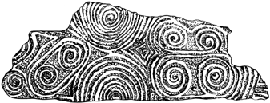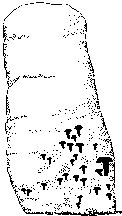Index Dutch Bronze Age
Index first farmers in the Netherlands
An introduction to Early Bronze Age Metalworking |
|
|
Objects made of gold and copper first appear in Britain around 2500 B.C.E. at a time of growth and development.
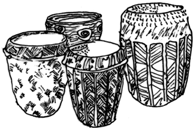 |
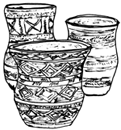 |
Earlier, the burial practises had changed with the closing of the long barrows, and Wood Henge and other timber henges were abandoned. The use of groove ware pottery gives way to beaker pottery, possibly a style imported from the Rhine area of Europe. This heralds a change in society and a new social elite. It is in the burials of these people under the round barrows that the first metal objects arrive, in what is referred to as beaker grave goods, in the form of tanged copper daggers, flat axes and what is thought to be gold basket earrings.

It is hard to imagine the
impact that those first metal implements had, but they were soon taken up as
symbols of power. In a time when society would have been very ritualistic,
smelting ores, turning stones into metal, and even pouring molten copper the
colour of the sun, must have had a deep magic attached to the metalworking
process.
Why did they go to all the effort of decorating an axe when the
haft would have covered a large area of it? Maybe it is the creation of the
object, with all the ritual attached, which give it its importance. There
are carvings of bronze axes on Stonehenge, all with the blade upwards with
no handles. Could this be a veneration of the bronze axes to the sun?
|
Over the next 800 years of the Early Bronze Age we see an intensive building of stone circles, and the embellishment of several henges with stone circles and later additions of avenues. Barrow cemeteries spread to create the enigmatic landscapes we see around Stonehenge and other prehistoric sites. As the artefacts are quite simple, people are unaware of the extraordinary effort the early metalworkers went to. It was a triumph of human ingenuity over a new material with limited equipment, - charcoal, clay, sticks and stones. |
|
|
Copper has a high melting point of 1086oC, but to get it to stay molten long enough to pour, it needs to be heated to 1300oC.
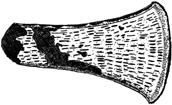
The clay crucibles were open and shallow and the heat
was applied from above. This reduced the thermal stress to the crucible by
passing the heat straight to the metal. Furnaces were probably a simple clay
retaining wall about 12 inches high to contain the charcoal fire, with the
air being blown with bellows through holes in the walls. Recovering the
crucible from a fire of 13000C is no mean feat. The heat radiated is so
intense that anything nearby will ignite. It seems most probable that they
used a wooden paddle to lift the crucible out of the fire, and then picked
it up with green sticks for pouring.
Due to the shallow crucibles and the
small volumes of metal the heat loss was very rapid, maybe they had as
little as twelve seconds to recover the crucible and pour the metal before
it chilled. Colour could be used as a temperature guide. Bright yellow in
the heart of the furnace would indicate a high enough temperature to melt
the copper. This would need to be done in the dark: maybe all the metal work
was done at night.
Copper, when molten, will absorb gasses from the atmosphere, which appear as holes when it solidifies. The longer it is exposed, the more holes there are in the casting. Leaving charcoal floating on the metal can counteract this. This presents no problem with an open mould but could spell disaster for a closed mould, either by blocking the entrance to the mould or getting trapped in the casting. Although simple stone moulds survive it is most probable that they mastered clay impression moulds, which would have needed to be fired simultaneously. Copper doesn't lend itself to casting interesting shapes so the moulds are more like simple billets, far from the desired shape.
After casting, the first step
would be to remove the casting gate and any surface debris before forging.
To obtain the basic shape, it would be necessary to forge the copper, when
hot, with stone hammers, and to achieve the final shape through cold
hammering it would require constant annealing (softening through heat).
Once
the finished shape has been cleaned of marks, by grinding with a wet stone,
decoration could be applied to copper axes and the recesses forged behind
the edge of the blades of copper daggers before the final hammer hardening.
The last stage would be to polish out the last hammer marks. It is most
probable that the decoration was applied with hammer hardened copper punches
while the axe was still annealed or still very hot. This might explain the
slightly wandering patterns.

Sometime around 2300 B.C.E., tin stated to be alloyed with
copper and this first appears in a group of metalwork called Brithdir metal
work (each group of metal work is named after the area in which it was first
found). It must have been hailed as a gift from the gods by the metal
workers, for the miraculous effect it had on copper.
By alloying just 10%
tin with copper would lower the melting point by 1000C. It also made metal
flow and cast better so you could cast nearer the final shape and create new
shapes. It reduced the oxygen absorption, thereby fewer holes and better
castings. The resulting alloy was much harder when cast, instead of the dull
thud of copper, it was hard enough to ring straight from the mould. With
cold hammering it went even harder but could be annealed in the same way as
copper. They soon worked out that 10-12% tin was the optimum: any more and
the alloy became too brittle, any less and it was too soft. Unlike copper,
bronze is brittle when hot, and they took advantage of this to remove
casting debris.

Even
though bronze was much stronger, forging and hammer hardening were still
important in finishing bronze axes. This is quite noticeable in Willerby
metalwork; being heavily forged along the narrow edge to make slightly
raised flanges, and highly decorated with blades that flare out quite
noticeably.
Bronze daggers of this period have also changed to riveted
handles, with three to six rivets, instead of tangs. Instead of forging
behind the edge of the blade, as with copper daggers, they moved further
into the blade with three or four lines for decoration. So accurate is the
forging that you could be forgiven for thinking that it was cast in and some
daggers being decorated inside the lines with hundreds of regularly spaced
dots. The finest examples are from the Wessex I Culture barrows.
The most fabulous burial of this period is the Bush Barrow near Stonehenge. Among the many gold and bronze objects is a dagger with a handle decorated with thousands of gold pins to form a zigzag pattern on the pommel. It must have taken hundreds of hours of painstaking work, with each pin being 0.2 mm in thickness. Arraton Down metal work follows on from Willerby. Some examples being highly decorated but the flanges are even more pronounced, possibly cast in and then forged to shape, with the cutting edge even more flared than before. Now you can see the bronze-smiths moving towards casting nearer the finished shape, and not going through some of the manufacturing processes of their predecessors.
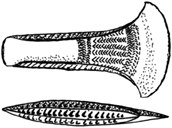
Bronze daggers also start to take a simpler form, with the lines being cast in. There is the trend towards longer blades that become dirks and rapiers of the Middle Bronze Age, and similarly with the raised flanges and stopping ridge on the axe developing to become the palstave axe.
After the Early Bronze Age, metal work develops with better casting techniques, but one can sense that it is losing some of its magic with items becoming more utilitarian in the Middle Bronze Age. Maybe ritualised metalworking carries on in the production of swords, with rapiers being cast in stone moulds. Could this have given rise to the sword in the stone of Arthurian legend?
More info about the writer / editor
